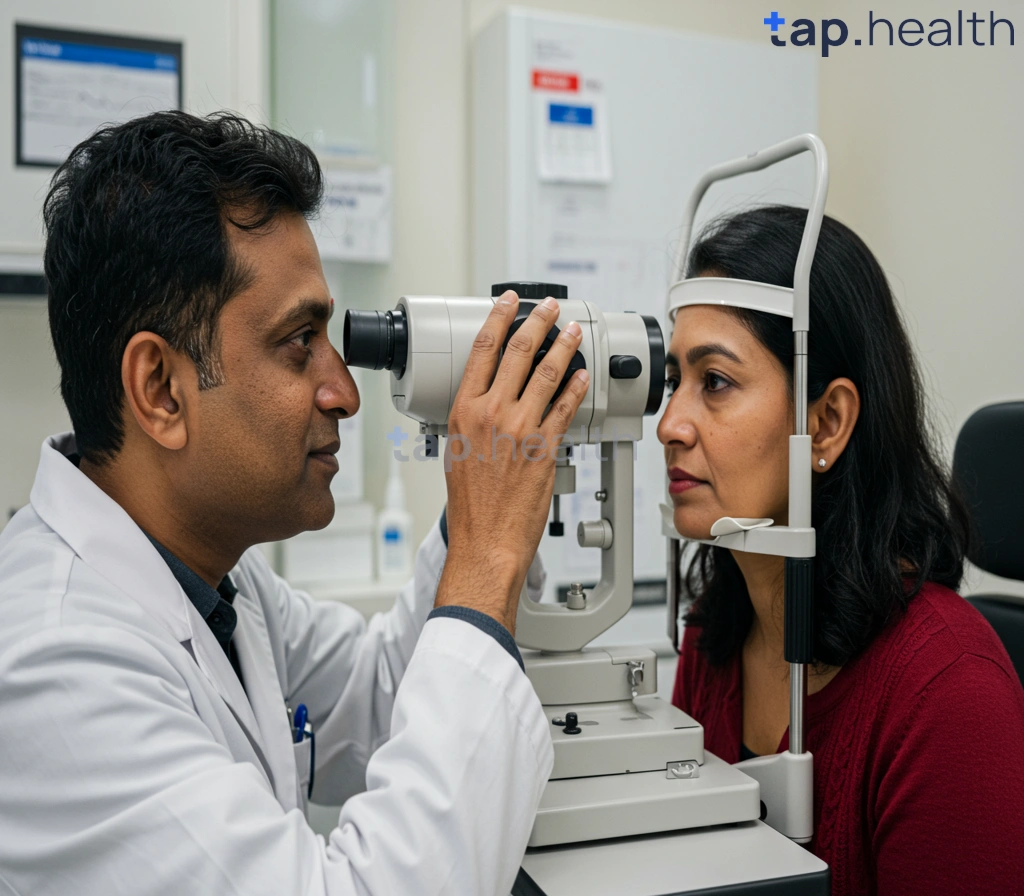Table of Contents
- Decoding Diabetic Retinopathy: Genetic Insights and Risks
- Diabetic Retinopathy: Understanding the Genetic Connection
- Genetic Predisposition to Diabetic Retinopathy: A Comprehensive Guide
- Is Diabetic Retinopathy Genetic? Exploring Family History and Risk Factors
- Preventing Diabetic Retinopathy: The Role of Genetics and Lifestyle
- Frequently Asked Questions
- References
Losing your sight is a terrifying prospect, and for those with diabetes, the risk of diabetic retinopathy is a very real concern. This devastating complication can lead to vision loss and even blindness if left untreated. That’s why we’ve embarked on a comprehensive study, Unraveling the Genetic Secrets of Diabetic Retinopathy, to better understand its underlying causes and pave the way for improved prevention and treatment. This blog will explore the latest research into the genetic factors contributing to this disease, offering insights into how these discoveries can transform patient care. Get ready to delve into the science and learn how we’re working towards a future with fewer cases of vision loss due to diabetes.
Decoding Diabetic Retinopathy: Genetic Insights and Risks
Diabetic retinopathy, a leading cause of blindness in India and other tropical countries, is significantly influenced by genetics. While lifestyle factors like blood sugar control play a crucial role, understanding the genetic predisposition is vital for early detection and preventative measures. Research suggests a complex interplay of genes contributes to the development and severity of this devastating complication of diabetes. This genetic complexity is further compounded by environmental factors prevalent in tropical climates, potentially increasing susceptibility.
Genetic Factors and Risk Stratification
Identifying specific genes linked to diabetic retinopathy is an ongoing area of intense research. Variations in genes influencing vascular development and inflammation are increasingly implicated. This research is crucial for developing personalized risk assessments, allowing for targeted screening and proactive interventions in high-risk individuals. Early identification, even before the onset of visible symptoms, is key to slowing progression and preventing irreversible vision loss. The high prevalence of diabetes in India necessitates a strong focus on genetic screening and early intervention strategies.
Regional Considerations and Implications
The impact of genetic predisposition to diabetic retinopathy varies across populations. In India and other tropical regions, specific genetic variations may interact with environmental factors like malnutrition, infectious diseases, and heat stress, potentially amplifying the risk. Understanding these regional differences is essential for tailoring public health initiatives and developing culturally appropriate interventions. Regular eye examinations are crucial, especially for individuals with a family history of diabetic retinopathy or other diabetic complications. Furthermore, managing blood glucose levels effectively remains paramount in mitigating the risks associated with this debilitating condition. The burden of diabetic neuropathy, affecting 30-50% of diabetic patients and causing pain and reduced mobility, highlights the overall importance of proactive diabetes management. For more information on maintaining good eye health, see our guide on How to Protect Your Vision with Diabetes: Essential Eye Care Tips. Managing diabetes effectively throughout life is also crucial, and you can learn more about the challenges and solutions in our article on Managing Diabetes as You Age: Challenges and Solutions.
Diabetic Retinopathy: Understanding the Genetic Connection
Diabetic retinopathy, a leading cause of blindness globally, disproportionately affects populations in India and other tropical countries. While high blood sugar is the primary culprit, genetics play a significant, yet often under-recognized, role in determining an individual’s susceptibility to this devastating complication of diabetes. Understanding this genetic predisposition is crucial for early detection and preventative strategies, especially within high-risk populations.
The Genetic Puzzle
Research reveals a complex interplay of genes influencing the development of diabetic retinopathy. Certain genes are linked to increased inflammation, impaired blood vessel function, and susceptibility to oxidative stress – all key factors in the disease’s progression. This genetic susceptibility, combined with the metabolic stress caused by diabetes, dramatically increases the likelihood of retinopathy. The presence of certain genetic markers can help predict individual risk, enabling proactive management and interventions.
Regional Considerations for India and Tropical Countries
In regions like India, where diabetes prevalence is high, the genetic landscape contributes to the significant burden of diabetic retinopathy. Specific genetic variations prevalent in these populations may further amplify the risk. Moreover, factors like lifestyle, nutrition, and access to healthcare all interact with genetic predisposition to influence disease outcomes. Early screening programs tailored to the unique genetic and environmental factors of these regions are critical. It’s also important to note that nearly 30% of people with diabetes also develop diabetic nephropathy, another serious kidney complication, highlighting the systemic nature of these conditions and the importance of holistic preventative care. It is also worth considering that diabetes can manifest in other ways, such as Does Diabetes Cause Hair Loss? Understand the Connection.
Taking Action
Regular eye exams are vital for early detection and timely intervention. Early diagnosis and treatment significantly reduce the risk of vision loss. Genetic testing, while not yet standard practice, may become increasingly important in the future, enabling personalized risk assessment and preventative care. By addressing the genetic component alongside lifestyle modifications and improved healthcare access, we can significantly improve outcomes for individuals at risk of diabetic retinopathy in India and other tropical countries. For more information on the connection between diabetes and another common issue, check out our article on Diabetes and Hair Loss: Is There a Connection.
Genetic Predisposition to Diabetic Retinopathy: A Comprehensive Guide
Diabetic retinopathy, a leading cause of blindness, significantly impacts individuals with diabetes, particularly within the 20-64 age group, comprising 61% of the diabetic population globally, according to the International Diabetes Federation. This statistic is especially relevant in Indian and tropical countries where diabetes prevalence is high. Understanding the genetic factors contributing to this devastating complication is crucial for early detection and preventative strategies.
Identifying Genetic Risk Factors
Research strongly suggests a significant genetic component in the development of diabetic retinopathy. Certain genes influence the body’s response to high blood sugar, impacting the blood vessels in the retina. While a specific “diabetic retinopathy gene” doesn’t exist, multiple genes interact, increasing or decreasing an individual’s susceptibility. This complexity underscores the need for comprehensive genetic studies, especially within diverse populations like those found in India and other tropical regions. Variations in these genes can influence the severity and progression of the disease.
Implications for Prevention and Treatment in Tropical Regions
The high prevalence of diabetes among individuals aged 20-64 in Indian and tropical countries necessitates tailored preventative strategies that incorporate genetic risk assessment. Early identification of individuals with a heightened genetic predisposition can facilitate proactive management of blood sugar levels and regular eye examinations. This early intervention can significantly reduce the risk of vision loss. Future research should focus on identifying region-specific genetic markers to optimize preventative care and improve outcomes for these vulnerable populations. Further studies are critical to understand how environmental factors interact with genetics in these specific regions. Understanding the genetic basis of diabetes itself is also crucial; you might find our blog on Can Diabetes Be Transmitted? Understanding the Facts and Myths helpful in this regard.
Actionable Steps
Individuals with a family history of diabetic retinopathy, or those belonging to high-risk populations in India and other tropical countries, should prioritize regular eye examinations. Maintaining strict blood sugar control, along with a healthy lifestyle, remains vital in mitigating the risk of developing this debilitating complication. Seeking advice from your ophthalmologist and diabetologist is essential. Early diagnosis and intervention are key to preserving vision. For those with Type 1 diabetes, understanding potential immune system implications is vital. Learn more in our article, Are Type 1 Diabetics Immunocompromised?.
Is Diabetic Retinopathy Genetic? Exploring Family History and Risk Factors
Understanding the Genetic Link
Diabetic retinopathy, a leading cause of blindness in individuals with diabetes, has a complex interplay of genetic and environmental factors. While not solely determined by genetics, a strong family history of diabetic retinopathy significantly increases your risk. This inherited predisposition can influence the severity and progression of the disease. Research consistently demonstrates a higher incidence of retinopathy among individuals with close relatives affected by the condition. This genetic susceptibility varies across populations, with regional differences potentially influencing prevalence in Indian and tropical countries. Further research is needed to fully understand these regional variations. The genetic component is also explored in the context of Type 1 Diabetes in our article, Is Type 1 Diabetes Genetic? – Tap Health.
Beyond Genes: Lifestyle and Environmental Factors
While genetics play a role, it’s crucial to understand that they are not the sole determinant. Poorly managed blood sugar levels, high blood pressure, and other diabetes-related complications are major contributors to diabetic retinopathy development. Lifestyle choices, such as diet and exercise, are equally impactful. The prevalence of sleep disorders among diabetics adds another layer of complexity. Studies indicate a 70% increased risk of sleep apnea and related sleep disorders in individuals with diabetes. These sleep disturbances can negatively influence blood sugar control, thereby exacerbating the risk of retinopathy.
Protecting Your Vision: Actionable Steps for Indian and Tropical Countries
In India and other tropical countries, regular eye examinations are crucial for early detection and management. Early diagnosis is key to preventing vision loss. This is particularly important given the high prevalence of diabetes in these regions. Maintaining healthy blood sugar levels through balanced diets, regular exercise, and adherence to prescribed medications are fundamental. Addressing any existing sleep disorders is equally critical for overall health and reduced retinopathy risk. Consult your ophthalmologist and diabetologist for personalized guidance and regular screening. Prioritizing eye health is an investment in your future, ensuring a better quality of life. Remember to schedule your Diabetic Eye Screening as recommended by your doctor.
Preventing Diabetic Retinopathy: The Role of Genetics and Lifestyle
Diabetic retinopathy, a leading cause of blindness in India and other tropical countries, is significantly influenced by both genetic predisposition and lifestyle choices. While genetics play a role in determining susceptibility, understanding that up to 80% of Type 2 diabetes cases – a major risk factor for diabetic retinopathy – can be delayed or prevented through lifestyle changes is crucial. This offers a powerful opportunity for proactive intervention and significantly impacts the risk profile. Early detection and management are key.
The Genetic Factor in Diabetic Retinopathy
Genetic factors influence an individual’s susceptibility to both diabetes and the development of diabetic retinopathy. Research continues to uncover specific genes linked to increased risk, although this is a complex interplay. Understanding your family history of diabetes and related eye conditions is therefore essential. However, simply having a family history doesn’t equate to a guaranteed diagnosis; lifestyle plays a significant part.
Lifestyle Interventions for Prevention
In India and across tropical regions, specific lifestyle modifications can effectively mitigate the risk. Maintaining a healthy weight through balanced nutrition rich in fruits and vegetables is vital. Regular physical activity, even moderate exercise, significantly improves insulin sensitivity. Controlling blood sugar levels through dietary choices and, if necessary, medication, is paramount. Regular eye examinations are crucial for early detection and management of retinopathy. Remember, up to 80% of Type 2 diabetes cases can be delayed or prevented through adopting a healthier lifestyle. For more information on supporting your health journey with dietary supplements, see our article on Safe and Effective Dietary Supplements for Diabetes Care.
Taking Control in Tropical Climates
The hot and humid climate prevalent in many tropical regions presents additional challenges. Staying hydrated is extremely important for overall health and may influence blood sugar control. Consult an ophthalmologist and diabetologist regularly, and actively participate in your healthcare. By proactively addressing lifestyle factors, individuals can significantly reduce their risk of developing diabetic retinopathy and protect their eyesight. Learning how to prevent long-term complications is key, and you can find helpful tips in our guide on How to Prevent Long-Term Complications of Diabetes: Easy Tips.
Frequently Asked Questions on Genetic Secrets of Diabetic Retinopathy
Q1. What is diabetic retinopathy and why is it a major concern, especially in tropical countries like India?
Diabetic retinopathy is a serious eye disease caused by high blood sugar that damages the blood vessels in the retina, leading to vision loss and blindness. It’s a major concern globally, particularly in tropical countries like India, due to a combination of high diabetes prevalence and genetic factors that increase susceptibility.
Q2. How do genes influence my risk of developing diabetic retinopathy?
Genetic predisposition significantly impacts your risk and the severity of diabetic retinopathy. Research shows multiple genes influence vascular development and inflammation in the eye, making some individuals more vulnerable than others. A family history of diabetic retinopathy increases your personal risk.
Q3. Besides genetics, what other factors increase my risk, and what can I do to mitigate them?
Environmental factors prevalent in tropical climates may interact with genetic susceptibility to increase the risk of diabetic retinopathy. However, maintaining good blood sugar control through diet, exercise, and medication is crucial. Regular eye exams, especially if you have a family history, are also vital for early detection and treatment.
Q4. How important is early detection and what should I do to get screened?
Early detection is crucial for preventing vision loss. Regular eye examinations, especially for individuals with diabetes and a family history of diabetic retinopathy, are recommended. These exams can identify the disease in its early stages, allowing for timely intervention and treatment.
Q5. Can genetic screening help assess my personal risk of developing diabetic retinopathy?
Personalized risk assessments using genetic screening are becoming increasingly important. While not yet standard practice, these tests can identify individuals with a higher genetic predisposition, allowing for proactive measures and more tailored management strategies.
References
- Diabetic Retinopathy Detection Using CNN with Residual Block with DCGAN: https://arxiv.org/pdf/2501.02300
- Diabetic Retinopathy Classification from Retinal Images using Machine Learning Approaches: https://arxiv.org/pdf/2412.02265





